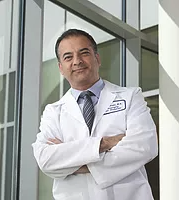Summary
A 36-year-old man presents with an acute subdural hematoma and no sign of head trauma. His friends say he’s complained of headaches and intermittent fever for weeks. The search for the hidden cause almost overlooks an obvious question. A decade later, neurosurgeons Dr. Kathryn Ko and Dr. Kaveh Barami say they’ll never forget this case.
Guests:

Kathryn Ko, M.D., MFA, FAANA
Dr. Kathryn Ko completed neurosurgery training at Mt. Sinai Medical Center and earned a Master’s of Fine Art in 2012. Her neurosurgery practice and art studio are located in New York City. She is the Artist in Residence at the Living Museum and served as the inaugural Artist in Residence for the American Medical Women’s Association. Her paintings, drawings, cartoons and videos can be viewed on Figure 1 and Instagram @doc_ambidexter. Learn more at www.kathrynko.com.

Kaveh Barami, M.D.
Dr. Kaveh Barami received his medical training at the University of Cincinnati College of Medicine and recently completed his fellowship in complex spine surgery at Kaiser Permanente’s Oakland Medical Center. He also has completed a fellowship in neuro-oncology.
Resources:
- Ruptured mycotic aneurysm presenting as an intraparenchymal hemorrhage and nonadjacent acute subdural hematoma: case report and review of the literature
- Infectious Endocarditis Associated with Subarachnoid Hemorrhage, Subdural Hematoma and Multiple Brain Abscesses
- Neurologic Complications in Infective Endocarditis
Transcript
DDx SEASON 1, EPISODE 5 TRANSCRIPT
The Source of the Bleed
RAJ: A 36-year-old man with a history of headaches and fever over the past month presents to the ER with rapidly declining neurological status.
Theme music
RAJ: This is DDx, a podcast from Figure 1 about how doctors think.
I’m Dr. Raj Bhardwaj.
Today’s case comes from Dr. Kathryn Ko.
KO: I’m a neurosurgeon practicing in New York City.
RAJ: We’ll also hear from a colleague she worked with on the case.
BARAMI: My name is Kaveh Barami, I am a practicing neurosurgeon in California.
RAJ: Dr. Barami is a neurosurgeon who was a junior staff under Dr. Ko at the time.
This case occurred more than a decade ago, but it’s one that both doctors still remember well.
The patient arrived with close friends who said he’d been complaining for weeks of headaches and intermittent fever. Earlier that night he had become lethargic.
KO: By the time he presented to the emergency room, although his pupils were initially the same size, they rapidly changed so that the left side became slightly bigger and he became more and more lethargic. His eyes were open. He was following some very rudimentary commands, like thumbs up, nothing more than that.
And so the emergency room doctor, in order to protect his airway, intubated him, and then they initiated rapid calls to the neurologist and the neurosurgery team and the intensive care unit staff members.
RAJ: Dr. Barami was the first member of the neurosurgery team to see the patient. By the time he spoke to the ER doc, the patient was unconscious and he’d had a CT scan.
BARAMI: His imaging showed an intracranial hemorrhage, specifically a subdural
hematoma.
I realized that this was an emergency and discussed it with my senior staff who was Dr. Ko at the time, and an emergency craniotomy and evacuation was planned to decompress the brain.
KO: Our working diagnosis at the time that the acute subdural hematoma had caused compression on the brain and brain shift from left to right, resulting in his deterioration of his neurological status. We did blood work immediately. The emergency room actually initiated it, and we found that the coagulation parameters were normal. The white count
was slightly elevated though.
BARAMI: And we were thinking, well, what is the source of this hematoma? These were question marks, in our heads, but our priority was to decompress the brain.
KO: We wanted to save his life. So we went right away to evacuate the subdural, now the
acute subdural was quite large, and we felt that this was what was causing his decline and it was also life-threatening. It was approximately two centimeters, in size from bones, inner table to cortical surface.
RAJ: As the patient was recovering from surgery, Dr. Ko and Dr. Barami started trying to get to the bottom of what had caused the subdural hematoma.
KO: There wasn’t any external signs of trauma and the history didn’t support it, but of course you always think that maybe there was some traumatic event that’s in the differential diagnosis of considering what caused this acute subdural hematoma. After examining the brain during the surgery we essentially ruled that out.
BARAMI: The following steps was really a detective story in the sense that, we were trying to tie together his history of fever and then his laboratory findings of an elevated white count and a heart murmur that one of the doctors picked up in the emergency room.
RAJ: One of the first things they did once the patient was stable, was a cerebral angiogram to narrow their differential diagnosis.
KO: The most likely possibility was some kind of a vascular malformation. Because of the location, I thought maybe it was an arteriovenous malformation, it didn’t look like an aneurysmal bleed or a typical berry aneurysm. It possibly could have been some kind of an infectious mycotic aneurysm. Those were the three things that one would consider.
We also took note that the white count was elevated along with his body temperature. So an infectious disease consult was obtained. We had taken blood cultures from the emergency room and all of that was in progress and pending.
So now at this point we have emergency room doctors, we have intensive care doctors, we have neurologists, we have a neurosurgeon’s team, we have now the radiologist doing the cerebral angiogram and we have infectious disease specialists.
RAJ: The angiogram confirmed that it was a mycotic aneurysm.
KO: And it was interesting because a mycotic aneurysm usually doesn’t result in this type of bleed. It usually results in an intracerebral hematoma. This was an acute subdural hematoma, little bit different. So there’s a few little glitches in this case that make it very interesting and an enigma.
RAJ: Meanwhile, the infectious disease specialists had found streptococcus viridans in the patient’s blood…
KO: So that now leads us down a path of where did this come from. So typically a mycotic aneurysm can occur as a result of an entity called bacterial endocarditis.
The cardiologist comes in, an echocardiogram is then done, which then isolates a bacterial endocarditis of the mitral valve.
So theoretically there is a bacterial emboli, a piece of the valve that came off and went into the bloodstream, ended up in the posterior cerebral artery, infected the distal branch of the area, and this burst and caused the hemorrhage and his neurological decline.
RAJ: With this diagnosis of bacterial endocarditis, they started the patient on IV antibiotics.
But they still didn’t know where the infection had come from in the first place.
KO: So the path to presenting on a neurosurgeon’s operating table goes down a long trail back through many specialists: Infectious specialists, cardiologists, and now, once we are getting the infection under control, the intensive care specialist is looking at where it came from.
It turns out that the bacterial seeding of the heart came from a tooth abscess. So he had relatively poor dental hygiene which resulted in an abscess. He got some dental care, and not enough, and it festered for a while then leading to bacterial endocarditis in the mitral valve, then leading to an emboli of bacterial infectious agent to the brain.
RAJ: A tooth…this patient almost died from a subdural hematoma, and it all started with a tooth infection.
KO: The tooth was removed by the dental service, so now we have the dental people doing an extraction and it did heal up, but it took a long time on IV antibiotics.
RAJ: Although the surgery and diagnosis of endocarditis all happened within a couple of days, the patient was in the hospital for about two months. First recovering from surgery and on antibiotics, and then, in physical rehab recovering from neurological deficits caused by the aneurysm.
Dr. Ko still finds herself wondering how much more quickly they would have come to a diagnosis had someone noticed the tooth infection right away.
KO: Had somebody looked in his mouth, had somebody asked his close associates, had he ever had, you know, anything else that he was going? Was he going to a dentist? Those types of questions are interesting to me.
I understand why they weren’t asked because it was a life-threatening situation.
RAJ: In hindsight, these kinds of questions tend to seem obvious. But at 3 o’clock in the morning in the ER, when a patient is going downhill fast, a thorough work-up and detailed history just aren’t always possible.
KO: I had to come in there and take the clot out so that he would survive. It’s a complicated case that hinges on a very simple thing.
RAJ: In tough cases, sometimes our colleagues pick up on small details that we’ve overlooked.
BARAMI: I think it’s so crucial to invite other disciplines into the workup and they just shed so much light and angles that you haven’t thought of.
KO: I have always valued the input from my colleagues in the different specialties. I think after this case I valued it even more, and I think that’s the biggest lesson here. To save a patient’s life, sometimes it takes a whole team.
RAJ: Thanks to Dr. Kathryn Ko and Dr. Kaveh Barami
This is DDX, a podcast by Figure 1 the knowledge-sharing app for doctors.
Figure 1 is an app that lets doctors share clinical images and knowledge about difficult-to-diagnose cases.
DDX is produced by Earshot Podcasts.
Sound design and mixing by Chandra Bulucon.
And our theme music is by Nathan Burley. The executive producers of DDx are Jesse Brown and Corey Marr.
In addition to her work as a neurosurgeon, Dr. Kathryn Ko is an accomplished multimedia artist. You can read about her medical cases and see the paintings they’ve inspired at figure1.com/ddx.
You can also follow Dr. Ko on the Figure 1 app at @Doc_AmbiDexter.
I’m Dr. Raj Bhardwaj. You can follow me on Twitter at @RajBhardwajMD.
Thanks for listening.





